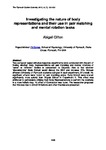Investigating the nature of body representations and their use in pair matching and mental rotation tasks
| dc.contributor.author | Clifton, A. | |
| dc.date.accessioned | 2019-05-14T14:02:40Z | |
| dc.date.available | 2019-05-14T14:02:40Z | |
| dc.date.issued | 2011 | |
| dc.identifier.citation |
Clifton, A. (2011) 'Investigating the nature of body representations and their use in pair matching and mental rotation tasks', The Plymouth Student Scientist, 4(1), p. 180-205. | en_US |
| dc.identifier.issn | 1754-2383 | |
| dc.identifier.uri | http://hdl.handle.net/10026.1/13931 | |
| dc.description.abstract |
Two computer based stimulus-response experiments were conducted with the aim of finding whether Body Representations aid pair matching and mental rotations of 'same‘ or 'different‘ Bodies in comparison to Bicycles. Also to find whether 'disconnecting‘ Body Stimuli would disrupt the BSD and increase RTs. Sixteen different University of Plymouth students took part in each experiment, 32 overall. No significant effects were found for pair matching alone. Body Stimuli were rotated significantly more quickly than Bicycle Stimuli in Experiment 2. This effect was attributed to participants utilising their Body Representations to perform the rotations in a more holistic way. No effect of Connection was found. The researcher proposed that this was due to stimuli limitations and other theories are presented. | en_US |
| dc.language.iso | en | en_US |
| dc.publisher | University of Plymouth | |
| dc.rights | Attribution 3.0 United States | * |
| dc.rights.uri | http://creativecommons.org/licenses/by/3.0/us/ | * |
| dc.subject | Body Representations | en_US |
| dc.subject | mental rotations | en_US |
| dc.subject | Body Stimuli | en_US |
| dc.subject | Bicycle Stimuli | en_US |
| dc.title | Investigating the nature of body representations and their use in pair matching and mental rotation tasks | en_US |
| dc.type | Article | |
| plymouth.issue | 1 | |
| plymouth.volume | 4 | |
| plymouth.journal | The Plymouth Student Scientist |



